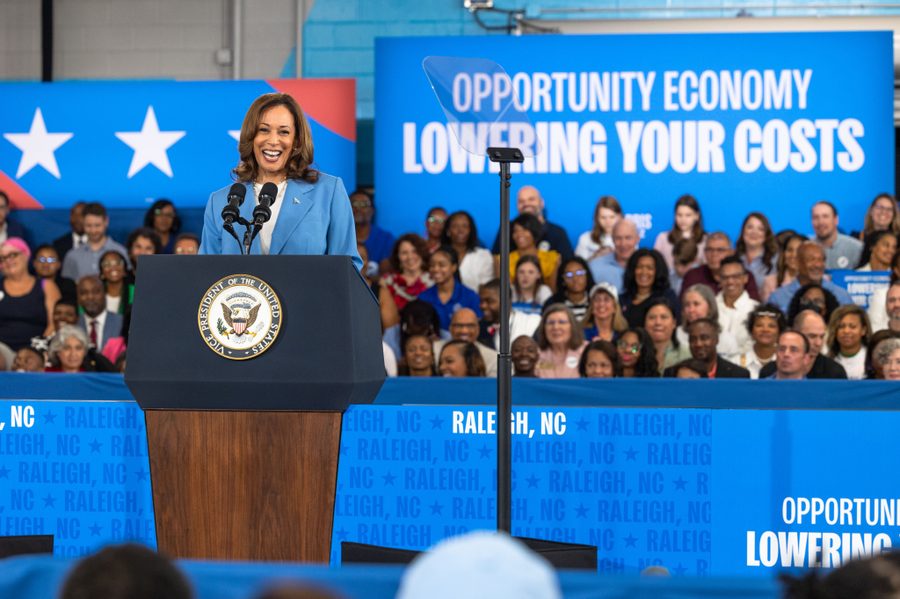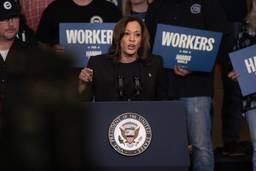Kamala Harris Can Do Better Than This
The most striking thing about the Democratic nominee’s economic platform is its timidity. She could go much further to lift up the working class.
Max B. Sawicky

In a speech in North Carolina last week, Vice President Kamala Harris put forward a raft of economic policy proposals which offer a first look at what the domestic agenda of a Harris administration could look like. With the Democratic National Convention in full swing in Chicago, now is a chance to take stock of what her platform could mean for the future economic direction of the country.
The Harris proposals stand in stark contrast to the Republican plans, which require little curiosity. One reason is that Donald Trump’s pledges were never worth much. Even as president, when he had majorities in Congress, we were treated to endless promises for a health insurance plan and an “infrastructure week,” but all we ever got were press releases.
We also already have the far right’s wish list, known as Project 2025, which advocates further slashing taxes for the rich and corporations, abolishing the Consumer Financial Protection Bureau and the Federal Trade Commission and shrinking the power of the National Labor Relations Board, among other retrograde ideas. In practice, the Trump administration’s actual record was signing off on traditional conservative demands for tax cuts and right-wing judicial nominations. Aside from hateful policies towards immigrants, women, and LGBTQ+ people, the possible initiatives for a second Trump term can be found on the policy pages of the Heritage Foundation.
With the polls beginning to swing in Harris’ direction, the Democrats’ plans are becoming more salient. In keeping with the usual risk-averse approach to politics, it may not be surprising to learn that Kamala-nomics is closer to Obama and the Clintons than to Bernie Sanders. While this may prove to be an effective electoral approach, it is a far cry from embracing a democratic socialist alternative to the Democratic Party’s centrist past.
That’s not to say that the party hasn’t moved to the left on economics — just look at the agenda pursued under President Biden. When the Biden administration had the benefit of Democratic control of Congress, its policies proved to be more progressive than might have been expected. Under a President Harris, we can expect continued energy applied to boosting antitrust and industrial policy. Anti-trust activism is devoted to curbing the excesses of monopoly domination of markets and blocking mergers that would further reduce competition. Industrial policy has been focused on energy transitions aimed at combatting climate change. Unfortunately, both of these subjects tend to slip off the public radar.
More prominent are proposed tax breaks. As usual, any reforms will depend upon how the next Congress shapes up, and whether Democrats can win the House and keep control of the Senate. One Harris proposal which would have an immediate impact on helping working families is bringing back the expanded Child Tax Credit (CTC), which briefly cut the child poverty rate nearly in half when it was in place in 2021, while also including something extra for newborns (a $6,000 “baby bonus”). Commitments in this vein are credible since they were enacted at least temporarily when Democrats held Congress, and something similar was part of Harris’s 2020 primary campaign.
One topic that has provoked dueling proposals from both Harris and Trump is the taxation of tips. What has largely escaped notice in this vein is that such a measure could actually end up increasing taxes for many low-wage workers. A better policy would be eliminating the subminimum wage for tipped workers altogether. It’s nice to know those who provide service earn living wages with benefits. Workers deserve the security of good wages.
Another new policy that is likely to catch the eye is a $25,000 first-time homebuyer’s tax credit, as well as more arcane tax credits to stimulate new housing construction with hopes of putting downward pressure on rents and house prices. People argue about it, and the evidence is actually mixed, but there is a supply-and-demand case that greater housing supply can push down rents and housing prices. Many people (including economists) will rightfully fear that the increase in supplied houses will not be affordable, so the idea is vulnerable to criticism in more than one respect. For her part, Harris says that by the end of her first term, her administration would spur the construction of three million new homes and rentals that are “affordable for the middle class.” Keeping such a promise is another story.
Harris has also outlined some more obscure proposals that aim to help consumers cope with a wide array of annoyances, including cancellation of subscriptions and memberships in health clubs, airline ticket refunds and filing health insurance claims.
Less credible are promises to deal with price-gouging of groceries and rents. Price regulation in the enormous U.S. economy is a challenging administrative burden, and some critics have likened such an approach to “communism.” President Richard Nixon proposed price controls in 1971, and nobody ever confused him with a communist.
The federal government can indeed affect specific prices for products where it is a very large purchaser. The leading example is prescription drugs, for which through Medicaid and Medicare the government is a huge buyer. In addition to Biden’s recently-introduced cap on insulin, comically taken credit for by Trump, further drug prices are also slated for reduction. The drive could actually go further in this direction by taking action on Bernie Sanders’ idea for the federal government to be more aggressive in negotiating further reductions in drug prices. Nor would it be rocket science to facilitate consumers’ purchase of legitimate prescription drugs by mail order from foreign sources.
The broader problem with price controls is that, just as inflation was not any president’s fault, reducing the price level for the economy as a whole is not easily within the reach of White House policy. By the way, it ought to be understood that inflation is the periodic increase in the price level. The latter is still elevated, compared to two years ago, which is what so aggrieves the public. Inflation itself has settled back down, after steadily falling.
Donald Trump has been chasing the inflation issue as well. His remedy is to “drill, baby, drill.” His problem is a lack of understanding that the global price of oil, which does indeed affect most everything else, is set by his friends in Saudi Arabia and Russia. It pays to recall that Trump once took special, aggressive steps to increase—not reduce—oil prices. Moreover, the United States is a net oil exporter, so any pricing problem is not due to lack of supply.
The most striking thing about Kamala-nomics is its timidity. This could be argued to be politically prudent. Forbes magazine, the self-described “capitalist tool,” tips us off that the program is not viewed with alarm by centrist or conservative minds. The polls are still close, and some commentators argue that a bid to the center is the best gambit. But what is left?
The biggest rap on the agenda, from a socialist standpoint, is its dependence on tax breaks. The progressive alternative, which can have a much bigger impact on lessening inequality, is more public spending. Housing is a good example.
Tax incentives to build housing may serve as a subsidy to builders and may not result in housing where it is most needed. The alternative to this neoliberal approach is to build social housing. Federal aid for this purpose is best channeled through state and local governments. This type of policy could deal in a focused way with housing shortages, which are location-specific. In fact, more broadly, the neglected socialist alternative to anti-trust (breaking up the big monopolies) is public ownership (the federal government competing with, if not replacing, some of those monopolies).
Another example is drugs. Vice President Harris probably remembers when she once endorsed Medicare for All. Rather than chip away at drug costs, wholesale expansion of Medicare and Medicaid, or even just ObamaCare, ought to be pursued to finally make healthcare a universal right. Or we could dream of a U.S. counterpart to the British National Health Service, much like our existing Veterans Affairs.
Broadly speaking, the revival of the Democratic pledge to avoid any tax increase on a family with income of less than $400,000 is an insurmountable barrier to social-democracy. Socialism means big public spending, for non-defense purposes of course, financed by mass taxation. And not necessarily simply progressive taxation. The country may not be ready for this, but it is the ultimate objective to be kept in mind.
The risks of a Trump victory are extremely high, and the Harris program would put the nation in an infinitely better place than the sorry alternative. Still, defeating the far right will likely require more ambitious plans to create lasting change. There’s no need to avoid setting our sights higher than what’s been offered so far.
Disclosure: Views expressed are those of the writer. As a 501©3 nonprofit, In These Times does not support or oppose any candidate for public office.
Max B. Sawicky is an economist and writer in Virginia, formerly with the Government Accountability Office and the Economic Policy Institute. He is a Senior Research Fellow at the Center for Economic and Policy Research and runs the MaxSpeak, You Listen! blog at sawicky.substack.com.











